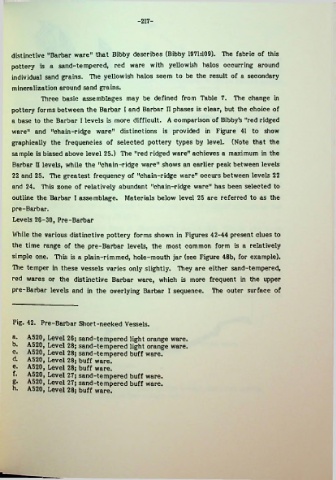Page 241 - Life & Land Use on the Bahrain Islands (Curtis E Larsen)
P. 241
-217-
distinctive "Barbar ware” that Bibby describes (Bibby 1971:109). The fabric of this
pottery is a sand-tempered, red ware with yellowish halos occurring around
individual sand grains. The yellowish halos seem to be the result of a secondary
mineralization around sand grains.
Three basic assemblages may be defined from Table 7. The change in
pottery forms between the Barbar I and Barbar II phases is clear, but the choice of
a base to the Barbar I levels is more difficult. A comparison of Bibby’s "red ridged
ware” and "chain-ridge ware" distinctions is provided in Figure 41 to show
graphically the frequencies of selected pottery types by level. (Note that the
sample is biased above level 25.) The "red ridged ware" achieves a maximum in the
Barbar n levels, while the "chain-ridge ware" shows an earlier peak between levels
22 and 25. Tbe greatest frequency of "chain-ridge ware" occurs between levels 22
and 24. This zone of relatively abundant "chain-ridge ware" has been selected to
outline the Barbar I assemblage. Materials below level 25 are referred to as the
pre-Barbar.
Levels 26-30, Pre-Barbar
While the various distinctive pottery forms shown in Figures 42-44 present clues to
the time range of the pre-Barbar levels, the most common form is a relatively
simple one. This is a plain-rimmed, hole-mouth jar (see Figure 48b, for example).
Tlie temper in these vessels varies only slightly. TTiey are either sand-tempered,
red wares or the distinctive Barbar ware, which is more frequent in the upper
pre-Barbar levels and in the overlying Barbar I sequence. Tlie outer surface of
Fig. 42. Pre-Barbar Short-necked Vessels.
a. A520, Level 26; sand-tempered light orange ware.
b. A520, Level 28; sand-tempered light orange ware.
c. A520, Level 28; sand-tempered buff ware.
d. A520, Level 28; buff ware.
e. A520, Level 28; buff ware.
f. A520, Level 27; sand-tempered buff ware.
g- A520, Level 27; sand-tempered buff ware.
h. A520, Level 28; buff ware.

